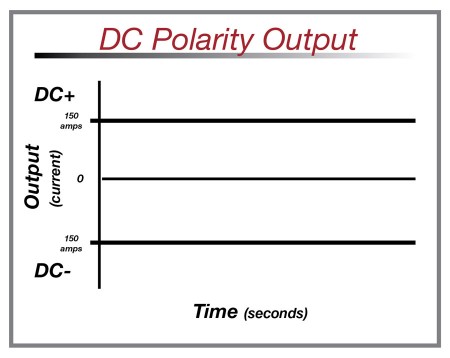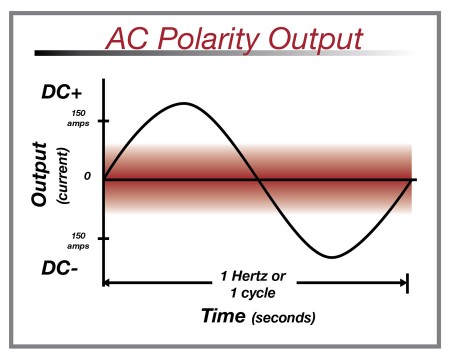
While DC stick welding is the go-to option, AC stick might offer a better solution in some cases
While DC stick welding is the go-to option, AC stick might offer a better solution in some cases
AC Vs DC Stick Welding
Welding Town
While AC/DC might make most reminisce about a certain era of rock music – I know I listened to plenty of the band’s music on KSHE 95 in St. Louis – to welders it means polarity. Stick welding is polarity driven. Direct current (DC) is used on most stick welding applications. Alternating current (AC) is typically only used as a second option.

Graph of welding output on DC+ or DC- polarity. As seen by the bold lines, the output is at a consistent current level all the time.
DC stick welding offers advantages over AC when welding steel, including smoother and more stable arcs, easier starts, fewer arc outages, less spatter and easier vertical up and overhead welding. DC positive polarity provides a high level of penetration into the steel. DC negative polarity results in less penetration but a higher deposition rate. It is sometimes used, for example, on thin sheet metal in an attempt to prevent burn-through.

“Because AC polarity is half DC positive and half DC negative, it is right in the middle,” says Kevin A. Beardsley, application engineer, The Lincoln Electric Co. “You can choose AC if you don’t want to go DC negative because you don’t want that much penetration.”
Graph of welding output on AC polarity. Note that 120 times per second, the welding output crosses the centerline, representing zero amperage or no output. With many electrodes the arc tends to frequently extinguish on AC polarity. To overcome this, some electrodes have elements in their coatings that help keep the arc ignited as the output goes through periods of low and no output (loosely represented by the red zone).
Beardsley emphasizes AC is almost always a secondary choice. Most welders don’t bother changing polarity because their other jobs run on DC positive.
When in need
There are, however, a few situations where AC polarity is used. The obvious one is when the only available power supply has AC output only. This is typical with low-cost, entry-level welding machines, such as the “buzz box” welder.
“Also, there are some specific technical problems associated with using DC polarity, and number one is arc blow,” says Eric Stewart, pipewelding technologist at Lincoln. “When welding, that arc has a shape and the welder wants to direct that arc into the joint to get full penetration. When there is arc blow, that arc is blowing to one side or the other.”

Stick electrode coating types and currents.
An effective fix to arc blow problems, therefore, is switching to AC instead of DC polarity. The arc blow can be caused by magnetism in the material being welded or can be induced by the arc’s current.
“You can magnetize with current flowing through, so where you put your grounds and things like that can impact arc blow. The arc is going to wander,” Stewart says, also mentioning that another possible cause can be an external source, such as windy conditions.
Because AC alternates between positive and negative polarity, it enables magnetized parts to be welded.
“If you were welding in a box and pushing toward the intersection where the vertical line comes down, the two horizontals meet into a corner,” Stewart says. “The magnetic forces in relation to joint geometry actually at that point create a turbulent puddle and that will result in a tremendous amount of spatter.”
When in use
One specific industry for AC stick welding is in shipbuilding, particularly when welding into a corner and arc blow becomes a problem. Another area is maintenance and repair.
“Those are the guys that will use AC stick welding more than anyone as a primary option,” Beardsley says. “Maintenance and repair welding requires work on machines that are magnetized. Also, maintenance and repair work can involve a lot of rusty weld areas, where you don’t want high penetration.”
A switch to AC polarity requires a power supply and electrode both designed to run AC. Again, because any production type of process is probably going to be DC, “if you want an AC capability, you have to specify that,” Beardsley says. AC/DC power supplies are available but on the higher end models.
Which stick?
With many electrodes, the arc tends to frequently extinguish on AC polarity. At the instant of the switch, the arc actually goes out and then has to re-establish itself. Electrodes are available with specific elements in their coating that operate on AC polarity to keep the arc ignited.
The 6011 welding rods have a high cellulose potassium-type coating. These rods can be used with AC and DC polarity for all-position welding. They work especially well for welding rusty, dirty or older metal or making repairs outside where it’s windy. The 6011 rods are the AC version of the popular 6010 welding rods for DC. The 6010 have a high cellulose sodium-type coating, can penetrate deeply and are used for many applications in the field.
Both are fast-freeze rods, meaning the weld puddle changes from liquid to solid rapidly, and are used primarily by pipefitters and pipe welders. Sizes vary, but 1.8 in. to 5/32 in. are prominent. Other AC welding rods include 6013, 7018 and 7024.
The 6013 rods are all-position AC or DC polarity for welding new, clean sheet metal applications because they penetrate less but don’t burn through the metal.
The 7018 welding rods are used for pipe welding and structural steel welding and repair welding. This low-hydrogen, usually DC, all-position electrode can also be used with AC, which not many welders may know. The 7018 provides a good bead appearance and smooth, strong welds. It also works on higher strength steels.
The 7024 welding rods, commonly referred to as Jet Rod, run well on AC. They are a good general-purpose rod with a high deposition rate for flat and horizontal welds and are typically used to make large welds. They have a heavy iron powder content. The 7024 rods are used for general fabrication, including deep grooves and big ships where a high-deposition rate is required.
Both the 7018 and 7024 rods are also known as “drag rod,” where the end burns off slightly inside the flux coating, allowing the welder to drag the rod along the joint. The heavy slag should just peel off leaving a smooth weld.



